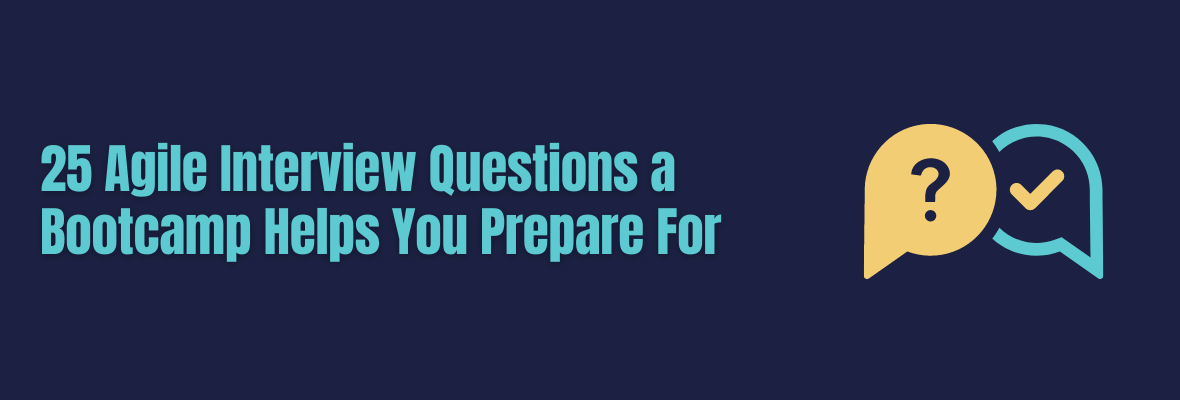25 Agile Interview Questions a Bootcamp Helps You Prepare For
The Agile framework is an essential program for technology companies characterized by efficiency, flexibility and communication. If you have an Agile interview and wonder what questions and discussions to prepare for, read on.
Whether you’re an applicant preparing for the interview or generating a list of key interview questions, this list of 25 commonly asked Agile interview questions and answers have you covered.
What To Expect in an Interview for Agile-Focused Positions?
World Economic Forum’s report on “Jobs of Tomorrow: Mapping Opportunities in the New Economy” lists Agile Coaching as one of the top three emerging jobs and skillsets needed in the emerging new global workforce.
An increasing number of companies are realizing a more effective way to work using Agile frameworks such as Scrum. One reason for the high demand for Agile roles in today’s job market is its ability to help organizations adapt and evolve more quickly.
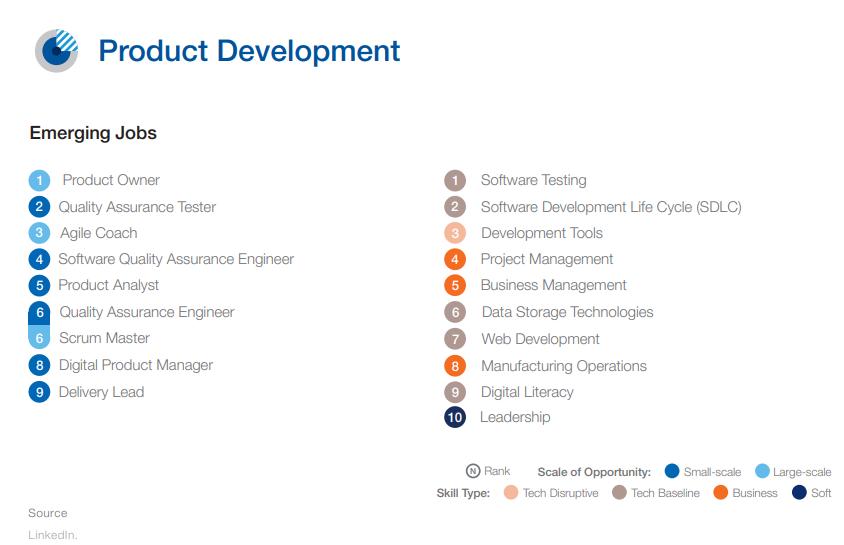
Source: World Economic Forum
As a result, organizations are actively looking for Agile professionals to help them transition to the Agile Scrum framework.
If you are wondering when the best time is to build a career in Agile, the answer is “Now.” Agile certification allows you to demonstrate your knowledge and authority in Agile practices necessary to implement in an organization. The same skills can be useful for project management across the business.
Agile-certified professionals can demand a higher salary, and they are preferable over their counterparts to demonstrate their skills and move up the career ladder. In a typical interview for an Agile-focused job, the Agile methodology interview questions would be technical and behavioral. The Agile methodology interview questions and answers would be process-oriented and designed to test your knowledge of Agile principles and best practices.
These 25 interview questions on Agile Scrum methodology can be your gateway to Agile jobs such as Scrum master, product owner and Agile coach.
25 Agile Interview Questions and Answers
This ultimate list of 25 interview questions on Agile Scrum methodology will answer your queries about the Agile methodology and its implementation in an organization.
1) What is Agile testing in an organization?
Possibly, this is the first Agile business analyst interview question to test your knowledge of the Agile basics.

Source: DZone
Agile testing follows the principles of Agile software development, aimed to include all members of an Agile team to ensure the product’s on-time delivery. Additional features then add on at frequent intervals.
The key elements of Agile testing are – clean code, customer satisfaction, collaborative work between developers and business analysts, constant feedback and continuous improvement.
2) How does the Agile methodology differ from the traditional waterfall approach?
This is one of the most frequently asked Agile interview questions, the answer should be at your fingertips. In the Agile framework, the company delivers software features frequently so that testing and development happen simultaneously. Consequently, the testing time is short since only small features need testing regularly.
On the other hand, the waterfall methodology involves the testing activity to take place at the end of the entire product development process. The user has to test the complete product, along with all functionalities, in one go, so the testing period is long.
The waterfall model is a closed process where all stakeholders may not be involved in the development process. Contrarily, Agile requires and allows stakeholders and customers to be involved at all stages.
3) Mention the pros and cons of the Agile framework in a business.
An important and often-asked Agile coach interview question, the answer is:
Pros of Agile framework in an organization:
- Quick and constant delivery of the software features to ensure customer satisfaction.
- Involvement of all stakeholders ranging from customers, developers to testers leading to technical excellence and great design.
- Facilitation of close interaction between business analysts and developers.
- The flexibility ensures adaptation of changing requirements. Changes required at the last moment or later on are easy to implement without any complication.
Cons of Agile framework:
- When the software deliveries are large, determining the effort required at the onset of the software development cycle becomes challenging.
- Documentation takes a hit in the Agile approach.
- In the development process, decision-making requires the expertise and experience that veteran professionals bring along. Freshers find it difficult to manage the Agile software development process.
4) What are the different types of Agile methodologies companies commonly implement?

Source: ALTRES
There are many types of Agile methods widely used in the business domain. The most widely used approach is Scrum. Other Agile approaches include Kanban, Crystal Methodology (CM), Dynamic Software Development Method (DSDM), Lean Software Development and Extreme Programming (XP).
5) What is the difference between the Scrum and the Agile approach?
Interviewers ask this Agile development interview question to confuse the candidate. By clearly answering and distinguishing the two concepts shows that you understand the nuances and associated processes.
The main difference between Agile and Scrum is that Scrum is a form of Agile while Agile is a method for project development. Both of them are flexible project management methods providing insights for structuring releases to achieve the best and quickest results.
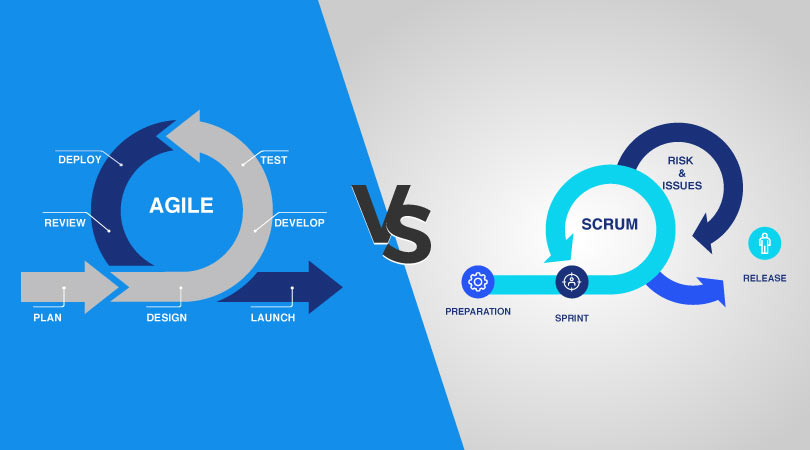
Source: PeppyBiz
Similarities, on the other hand, include that they both need client feedback. The introduction of sprints into the Agile methodology is the distinguisher Scrum brought about.
Sprints are sessions in which tech people develop product features. You could say, “Having the experience of working in Agile and Scrum domain, I prefer using Scrum within the Agile framework to work closely with multiple teams to achieve the release goal.”
6) When to use the Agile methodology?
While the traditional waterfall method is more suited for projects with a predefined scope and clear requirements, the Agile methodology is ideal for projects with dynamic requirements. When frequent changes and requirements come up on a regular basis, feature-driven Agile is the suitable framework.
7) Where can you apply Agile methodology?
Along with software testing, the industries that benefit from the Agile approach include supply chain management, manufacturing IT, pharmacy, health care, construction and banking among many others. The multitude of benefits Agile affords make it a commonly used methodology for change and transformation.
8) What are burn-down and burn-up charts?
Agile uses these charts to track the progress of ongoing projects. While the burn-up chart shows the completed work, the burn-down chart highlights the remainder of the tasks in a project.

Source: Clarios Technology
The four types of burn-down charts are:
- Product burn-down chart
- Sprint burn-down chart
- Release burn-down chart
- Defect burn-down chart
9) Define the main roles in Scrum.
The three main roles in a Scrum team are:
- Product Owner – They hold the responsibility of managing product backlogs. Working with end-users, the development team and customers, product owners provide requirements to the team to build the product.
- Scrum Master – Working with the Scrum team to ensure that it completes each sprint in a timely way, the Scrum master’s responsibility is to build a proper workflow for the team.
- Scrum Team – Each member of the team is ideally self-organized, dedicated and responsible for delivering high-quality work.
10) Explain what is a sprint backlog and product backlog in Agile.

Source: ToolsQA
This is a commonly asked Agile project management interview question. The product backlog is the responsibility of the product owner ensuring that the project includes every feature and requirement.
Treated as a subset of the product backlog, sprint backlog contains features and requirements related to a specific sprint.
11) What is velocity in Agile methodology?
A frequently asked Agile business analyst question, the answer is, velocity is a planning tool used to get an estimate of the speed of work and the time required to complete the project. This analyst does this calculation by reviewing the work successfully done in the earlier sprints.
For example, if the team finished five stories in a two-week sprint and each story had three story points, the velocity of the team is 15 story points for each sprint.
12) Can you explain pair programming and its benefits?
A common Agile business analyst interview question, pair programming is a method for two programmers to work as a team. While one programmer writes the code, the other reviews it. Both roles are switchable.
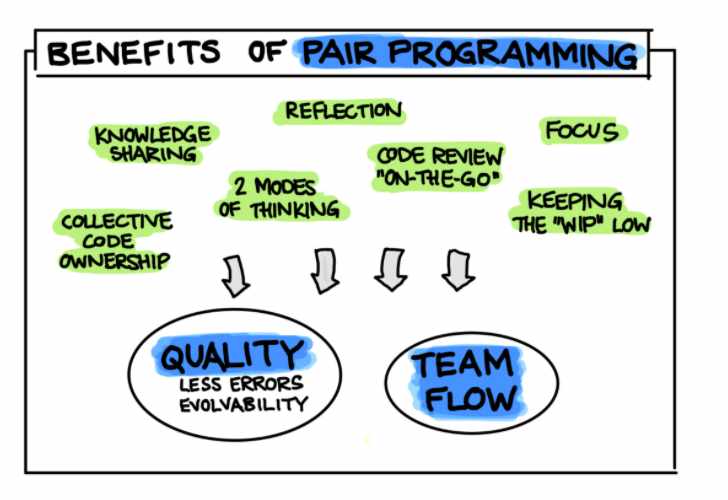
Source: MartinFowler
The benefits of pair programming are:
- Improved Code Quality – as the partner reviews the code simultaneously to reduce the errors.
- Easy Knowledge Transfer – The experienced partner can teach the other about techniques and coding.
13) What is Kanban?
Kanban is an Agile tool helping the team keep a close eye to track the work and measure its progress. This frequently asked Agile Scrum methodology interview question is one you should thoroughly prepare for.
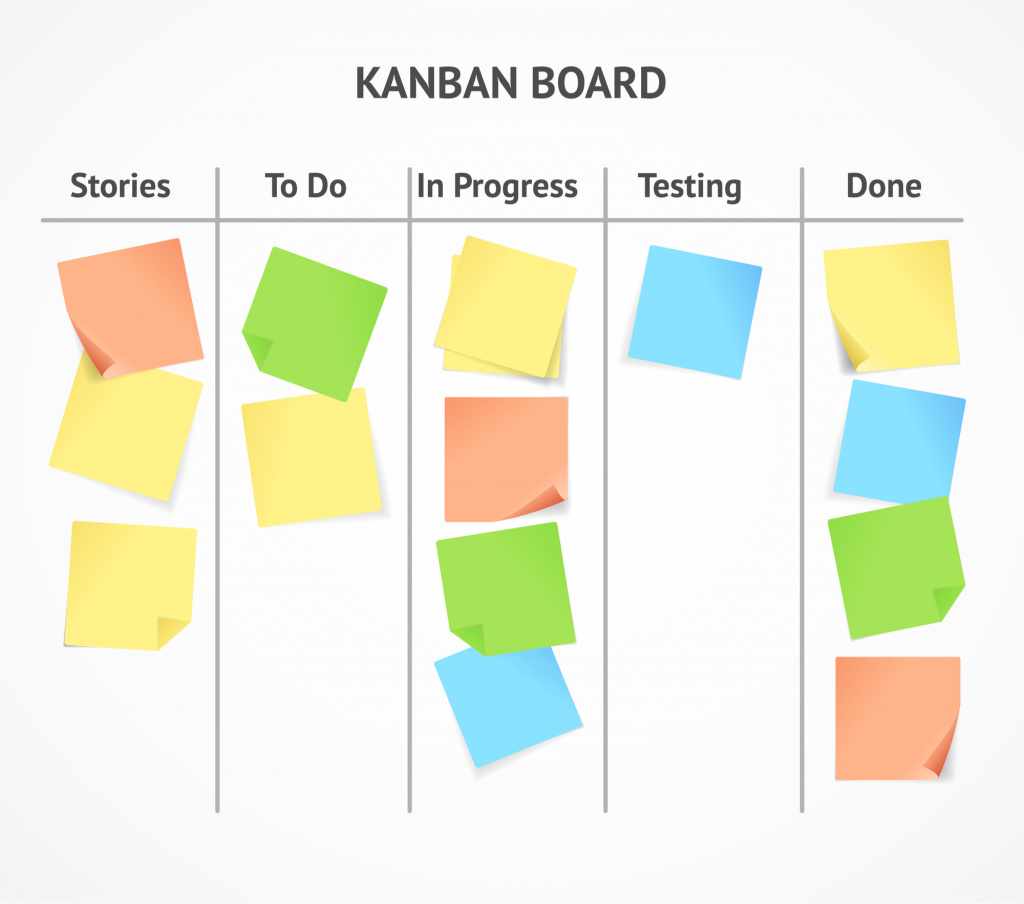
Source: Medium
Along with tracking the progress, using a “Kanban board” it’s easy to describe the status of development stories. It helps to write the whole scenario of the project in a single place. That way, you can picture the theme challenges, bottlenecks, tasks done and workflow progress.
The application of Kanban in Agile is to ensure continuous delivery of the product without overwhelming or overburdening the team.
14) Can you spot any difference between incremental and iterative development processes?
Yes, there is a clear difference.
The iterative approach of software development permits development without any interruption. The software development cycles such as sprint and releases repeat until the final product is ready.
In the incremental methodology, the product design, testing and implementation are regularly run until the product finishes. This way, it involves both development and maintenance.
15) Can you differentiate between epic, user stories and tasks in an Agile methodology?
The answer to this Agile development interview question is:
- User Stories – They define the actual business requirement, and the business owner often creates it.
- Tasks – To accomplish the business requirements or product requirements, the development team breaks it down into tasks.
- Epic – It is a group of related user stores.
16) What are the qualities of high-performing Agile teams?
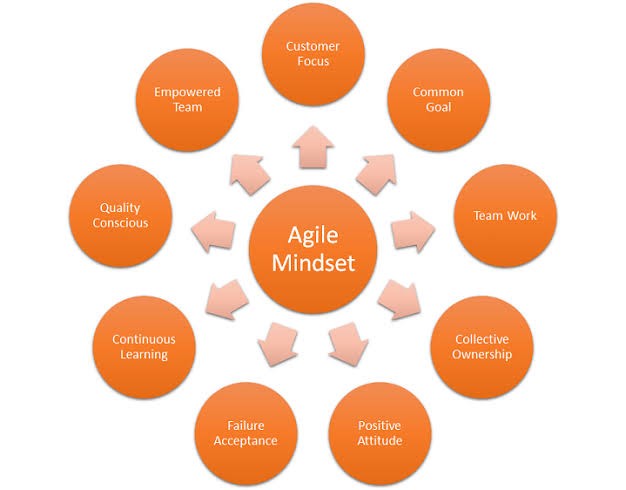
Source: Medium
Agile teams are critical for project management in the software industry. Successful and high-performing Agile teams exhibit these seven qualities.
- Self-organization
- Collaboration
- T-shaped skills
- Team agreement as individual roles and responsibilities take a backseat
- Continuous improvement
- Team success over individual achievements
- Supportive leaders
17) What are the important Agile Matrices?
The commonly known and frequently used Agile Matrices are:
- Velocity – To keep track of the project’s pace so that everyone on the team can have clarity on the progress, status and capacity.
- Work Category Allocation – For a clear idea about where different team members are investing in their team, allocating separate work categories is effective. This shows the order of priority for the project’s tasks.
- Defect Removal Awareness – The quality of the end product improves significantly when team members work actively to correct the errors simultaneous to developing and testing the product.
- Cumulative Flow Diagrams – They represent the time (on the X-axis) and the the effort of team members (on the Y-axis).
- Sprint Burn-down Metric – The best way for the Agile team to track and monitor the completion of the work with the sprint is by measuring the burn-down metric.
- Delivering Business Value – Mainly, this entails tracking the overall efficiency of the Agile team. Because the truth is only when all team members are productive and active will the Agile team deliver value to clients.
- Time Coverage – This is the time required to develop each iteration.
- Defect Resolution Time – It implies the time required to detect bugs and fix issues. As the name suggests, this elaborate process requires the Agile team to collaborate and deliver improved products, results or features in a productive way.
18) What are the responsibilities of an Agile Scrum master?
A popular Agile coach interview question, remember, in a nutshell, the Scrum Master is the leader and supervisor of the entire Scrum team. The main job of a Scrum Master is to ensure the team follows the Agile values and principles and the set processes and practices.
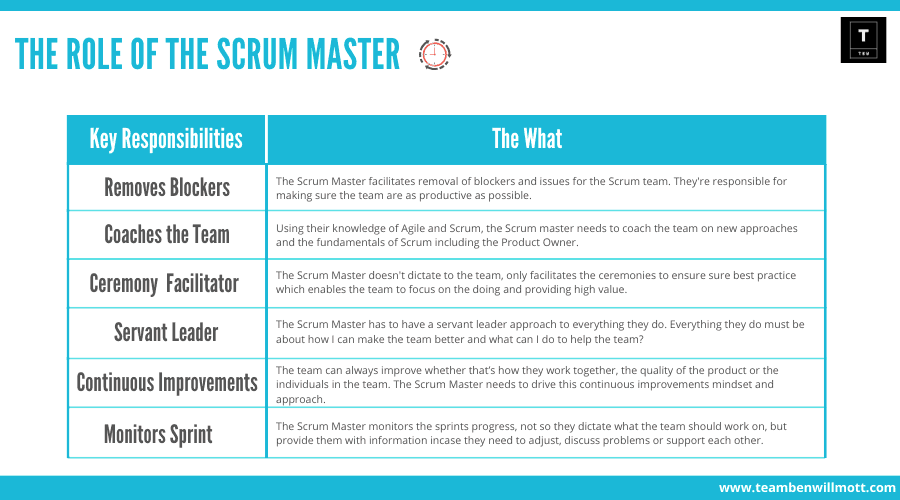
Source: PPM Academy
The critical responsibilities of a Scrum Master, regardless of the organization’s size and industry are:
- Eliminating roadblocks that reduce the productivity of the Scrum team
- Establishing a productive and collaborative work environment
- Protecting the team from interruptions from the outside world
- Maintaining a good relationship between the client, team and all stakeholders
- Supervising the operations of the Scrum team, firefighting internal team issues or inter-team challenges and motivating them, when needed
19) What is the ideal duration of the Scrum sprint?
The duration of a Scrum cycle, also known as a Scrum sprint, mainly depends on the project size and the team size.
Suppose the Scrum team has three to nine members and three to four weeks to complete the Scrum cycle. By this calculation, the average duration of the Scrum Sprint is four weeks.
20) Define a task board in Agile methodology.
In short, the task board is a dashboard displaying the project’s progress.
The elements in a task board are:
- User Stories – Actual business requirement
- To-do’s – Tasks that are just starting or features under development
- To Verify – Tasks that are yet to have verification and testing
- Knowledge Transfer – An experienced partner can teach others about the tasks and coding required.
21) How do you deal with a situation where the requirements are frequently changing?
This Scrum Master interview question is to test your analytical capability.
Your answer could be on similar lines using effective Agile change management capabilities.
- Involve the customer throughout the development process
- Design a product backlog that can accommodate continuous change
- Involve the client in daily standup meetings
- Use Agile task boards for efficient project tracking
22) Name some tools frequently used in Agile software development.
- Source Control Tools – Git, Mercurial and Subversion.
- Continuous Integration Tools – Jenkins, Travis CI and Strider.
- Team Management Tools – ActiveCollab, HP’s Agile Manager, JIRA, Agile Bench, VersionOne, Pivotal Tracker, Planbox, LeanKit and Axosoft.
A successful Agile development process enables flexibility while maintaining discipline in the organization. A good set of Agile project management tools helps track the project and organize the team’s progress by not imposing tight deadlines and strict roles but by making it easier for developers to self-manage their goals.
These tools support the Agile project by allowing the team to identify requirements and splitting them into smaller tasks. From then on, it tracks the developers as they work collaboratively. The Scrum process of the Agile framework splits into shorter cycles that gradually result in the final product. The cycle keeps alternating between planning sessions and running code sprints.
23) What are some of the Agile quality strategies?
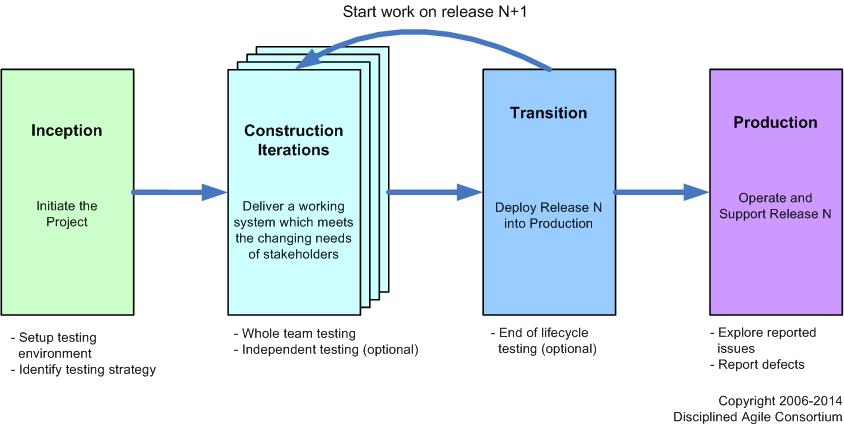
Source: Ambysoft
The answer to this Agile coach interview question is, here are some of the main Agile quality strategies.
- Re-factoring
- Creating small feedback cycles
- Undertaking dynamic code analysis
- Continuous iteration
24) What is the importance of daily standup meetings in an Agile Scrum methodology?
In brief, a daily standup meeting helps the team members communicate, seek support and track progress or roadblocks. This way, you can understand the colleague’s workload and priorities and what is happening within the business.

Source: Docket
The five benefits of daily standups in Agile are:
- Communication
- Transparency
- Trust
- Highlighting issues
- Empowering the team
25) What is the Agile Manifesto?
The Agile Manifesto, published in 2001, is a document with four values and 12 principles vital for Agile software development. This documentation is a result of software development practitioners who found the need for an alternative to documentation-driven and heavyweight software development methodology.
The four core values are:
- Individuals and interactions over processes and tools
- Working software over comprehensive documentation
- Customer collaboration over contract negotiation
- Responding to change over following a plan
The 12 Principles of the Agile Manifesto are:
Along with these Agile project management interview questions, the interviewer may ask questions based on your previous experience.
If you have had any experience of working with the Agile methodology, you may want to re-visit your job listing and prepare the answers for Agile Scrum methodology questions such as:
- What was the duration of sprints for the projects you worked on, in the previous organization?
- What is the highest number of Scrum projects you have handled, managed, or been a part of?
- What kind of project management tools have you used in the past?
- How was your experience of using automated Agile testing tools?
- Did any of your iterations overlap?
How Does a Bootcamp Help You Prepare for Agile Interview Questions?
Now that you know the important Agile interview questions and answers, a bootcamp is an intense program that gives comprehensive training on Agile methodologies. Along with a complete understanding of the Agile and Scrum frameworks, the Scrum Master (CSM®) certification bootcamp facilitates the expansion of your job prospects across industries implementing Agile practices.
Here are the seven reasons why you should consider joining the GreyCampus Scrum master certification bootcamp.
1) Instructor-led Training – Training sessions led by instructors are a great opportunity to connect with qualified and experienced Agile professionals who cover the most crucial and challenging topics of the Agile framework.
2) Experiential Learning With Case Studies – The Scrum master certification bootcamp allows you to take inspiration from industry case studies while learning the Agile methodologies. You can implement the ideas from these case studies in a practical environment.
3) Access to Scrum Educational Units – You can submit the professional units you earn from the certification bootcamp to global organizations such as PMI (Project Management Institute).
4) Multiple Attempts at the CSM Exam – When you attend the Scrum Master certification bootcamp, you will realize that the CSM online test is not difficult. The bootcamp allows you to take multiple attempts at the CSM examination.
5) 24/7 Learner Support – Tutors provide support round the clock, to answer your queries whether it’s via phone, live chat or email. That way, you will end up avoiding the common Scrum mistakes.
6) Access to PMI-ACP Course – The one-year access to PMI-ACP courseware equips you to better address an organization’s Scrum.
7) Scrum Alliance Membership – The Scrum Alliance membership included in GreyCampus’s CSM bootcamp provides an added boost to your professional career. You get to network with Agile and Scrum professionals globally. These connections could be instrumental in getting your dream job.
Wrapping Up
If you are looking to climb the corporate ladder by upskilling to an Agile career, GreyCampus, the leading provider of Scrum Master certification training bootcamp has trained thousands of learners. The Agile bootcamp covers Agile and Scrum and fundamental values that you can use in industries and organizations.
Want To Become a Scrum Master? Get Agile Scrum Certified Today!
